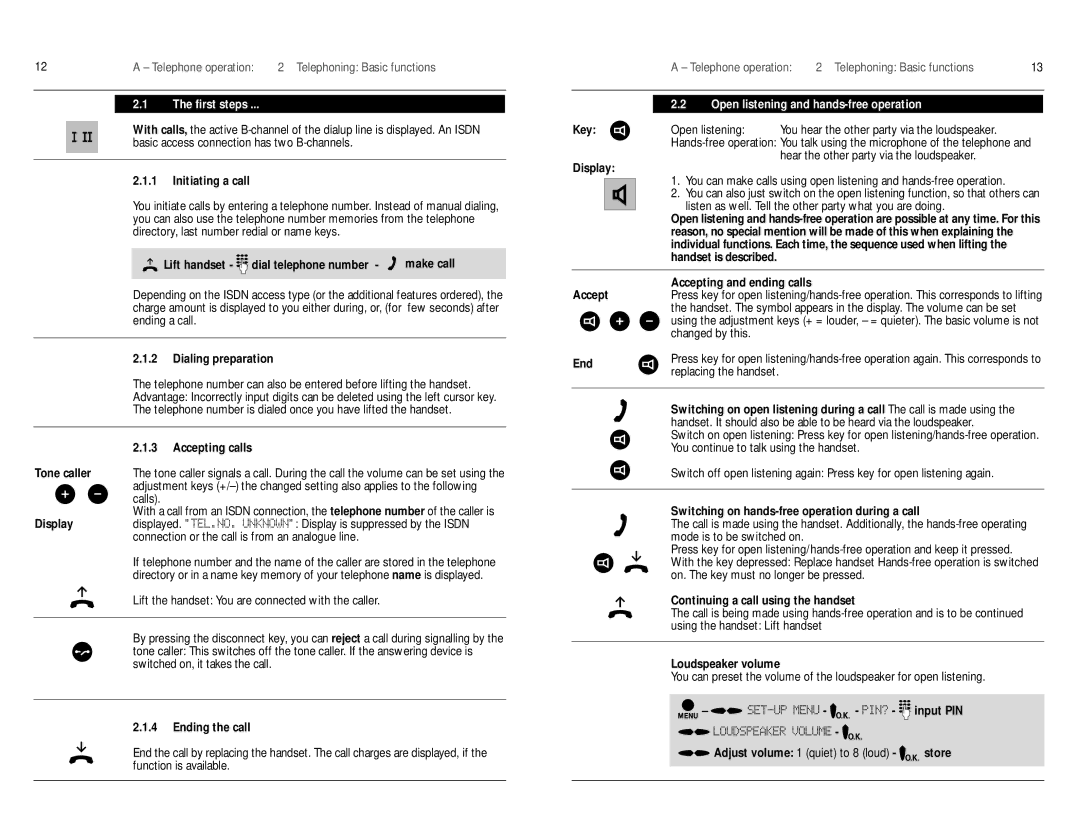
12 | A – Telephone operation: | 2 Telephoning: Basic functions |
2.1The first steps ...
With calls, the active
2.1.1Initiating a call
You initiate calls by entering a telephone number. Instead of manual dialing, you can also use the telephone number memories from the telephone directory, last number redial or name keys.
Lift handset - dial telephone number - | make call |
Depending on the ISDN access type (or the additional features ordered), the charge amount is displayed to you either during, or, (for few seconds) after ending a call.
2.1.2Dialing preparation
The telephone number can also be entered before lifting the handset. Advantage: Incorrectly input digits can be deleted using the left cursor key. The telephone number is dialed once you have lifted the handset.
2.1.3Accepting calls
Tone caller | The tone caller signals a call. During the call the volume can be set using the | |
| adjustment keys | |
| calls). |
|
| With a call from an ISDN connection, the telephone number of the caller is | |
Display | displayed. ” | ”: Display is suppressed by the ISDN |
connection or the call is from an analogue line.
If telephone number and the name of the caller are stored in the telephone directory or in a name key memory of your telephone name is displayed.
Lift the handset: You are connected with the caller.
By pressing the disconnect key, you can reject a call during signalling by the tone caller: This switches off the tone caller. If the answering device is switched on, it takes the call.
2.1.4Ending the call
End the call by replacing the handset. The call charges are displayed, if the function is available.
A – Telephone operation: | 2 Telephoning: Basic functions | 13 |
2.2Open listening and hands-free operation
Key: ![]() Open listening: You hear the other party via the loudspeaker.
Open listening: You hear the other party via the loudspeaker.
hear the other party via the loudspeaker.
Display:
1.You can make calls using open listening and
2.You can also just switch on the open listening function, so that others can listen as well. Tell the other party what you are doing.
Open listening and
| Accepting and ending calls | |
Accept | Press key for open | |
| the handset. The symbol appears in the display. The volume can be set | |
| using the adjustment keys (+ = louder, – = quieter). The basic volume is not | |
| changed by this. | |
End | Press key for open | |
replacing the handset. | ||
| ||
|
| |
| Switching on open listening during a call The call is made using the | |
| handset. It should also be able to be heard via the loudspeaker. | |
| Switch on open listening: Press key for open | |
| You continue to talk using the handset. | |
| Switch off open listening again: Press key for open listening again. | |
|
| |
| Switching on | |
| The call is made using the handset. Additionally, the | |
| mode is to be switched on. | |
| Press key for open | |
| With the key depressed: Replace handset | |
| on. The key must no longer be pressed. | |
| Continuing a call using the handset | |
| The call is being made using | |
| using the handset: Lift handset | |
|
|
Loudspeaker volume
You can preset the volume of the loudspeaker for open listening.
– | - | - | - | input PIN |
|
| - |
|
|
| Adjust volume: 1 (quiet) to 8 | (loud) - | store | |
